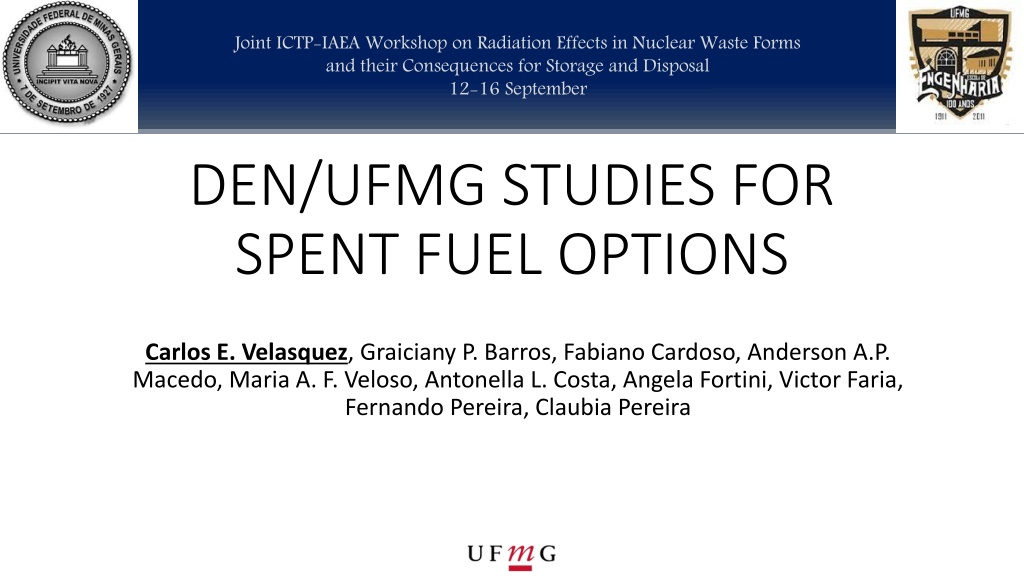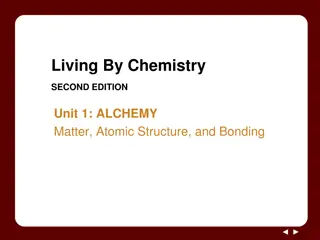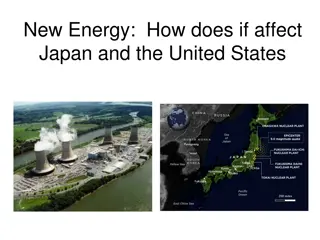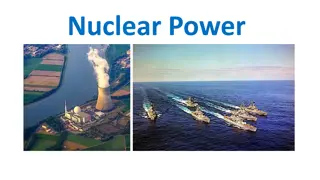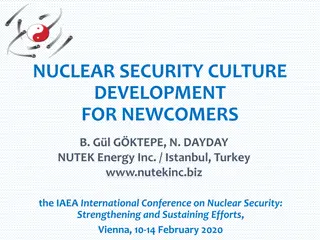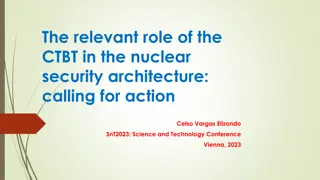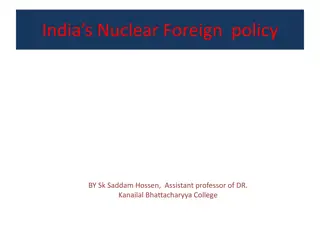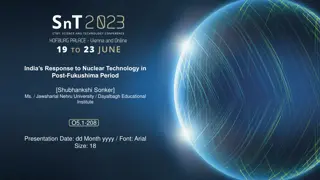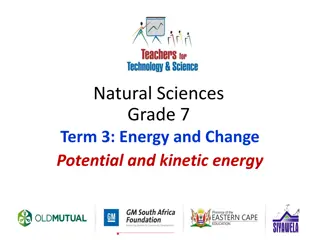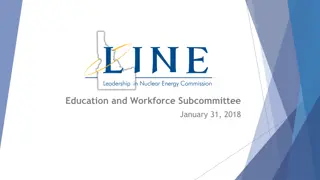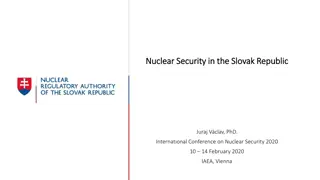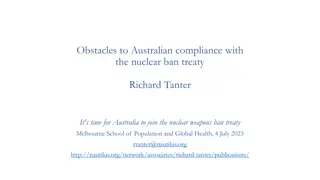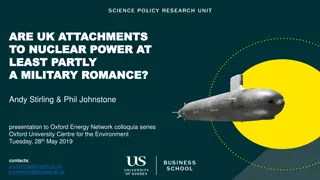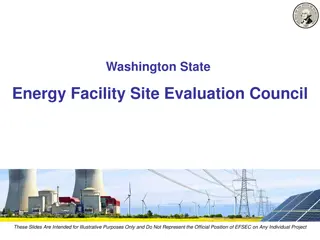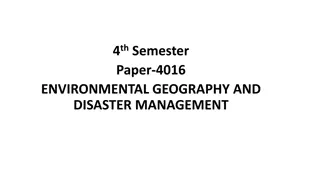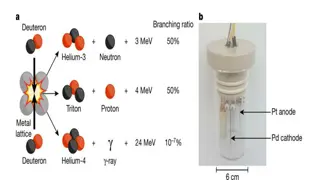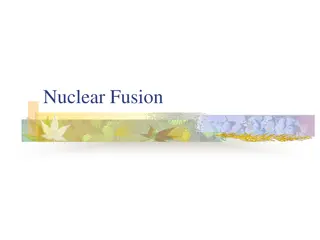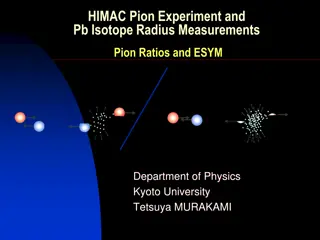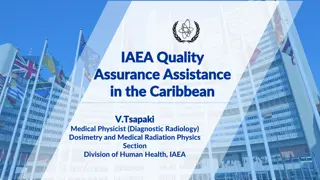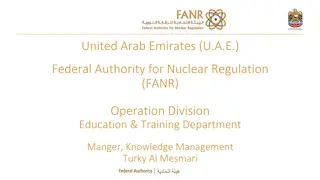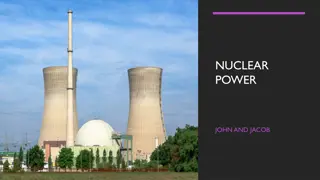Advancements in Nuclear Energy Research and Technology at UFMG
Explore the latest developments in nuclear energy research and technology at UFMG, including studies on radiation effects, nuclear waste forms, thorium reserves, and the National Institute of Science and Technology for Innovative Nuclear Reactors. The Nuclear Engineering Department at UFMG focuses on training students in various nuclear research fields, such as reactor technology, fuel cycles, and thorium fuel investigations.
Download Presentation

Please find below an Image/Link to download the presentation.
The content on the website is provided AS IS for your information and personal use only. It may not be sold, licensed, or shared on other websites without obtaining consent from the author. Download presentation by click this link. If you encounter any issues during the download, it is possible that the publisher has removed the file from their server.
E N D
Presentation Transcript
Joint ICTP-IAEA Workshop on Radiation Effects in Nuclear Waste Forms and their Consequences for Storage and Disposal 12-16 September DEN/UFMG STUDIES FOR SPENT FUEL OPTIONS Carlos E. Velasquez, Graiciany P. Barros, Fabiano Cardoso, Anderson A.P. Macedo, Maria A. F. Veloso, Antonella L. Costa, Angela Fortini, Victor Faria, Fernando Pereira, Claubia Pereira
Nuclear Energy in Brazil Currently, there are two reactors operating Angra I and Angra II, in Brazil. The third reactor Angra III is under construction. The nuclear contribution to the electricity generation is about 1.4% 02/10/2024 UFMG 2
Thorium reserves Thorium is a valuable resource since it is about three to four times more abundant in the earth s crust than uranium Thorium reserves Other Countries Kazakhstan Sweden Finland Greenland China South Africa Russia Canada Venezuela Norway Egypt USA Australia Brazil Brazil world thorium reserve. Turkey has the third India 0 200000 400000 Tonnes 600000 800000 OECD NEA & IAEA Uranium 2011: Resources, Production and Demand (Red Book) 2011 02/10/2024 UFMG 3
(INCT) National Institute of science and technology of innovative nuclear reactors Mission Accomplish exploiting the nuclear natural resources especially uranium Research and development of new nuclear technology Human resources training Promote nuclear energy for public acceptance 02/10/2024 UFMG 4
Nuclear Engineering Department DEN/UFMG The nuclear engineering department (DEN) called PCTN at UFMG was founded in 1968. The PCTN commitment is to deepen the professional and academic knowledge in the nuclear area. Training students in the nuclear research 02/10/2024 UFMG 5
Study Fields Nuclear Reactor and Nuclear Fuel Cycle Technology Reactor and nuclear fuel cycle physics Sub-critical and minor actinide systems Long-lived fission products recycle High temperature reactor Advanced PWR Thermal-hydraulic analysis Thorium fuel cycle investigations 02/10/2024 UFMG 6
The Issue of Nuclear Energy Since the beginning of the nuclear fission era, SNF or nuclear waste has been produced. The majority of the spent fuel goes to a final repository far away and secures enough to the population contact. Nevertheless, the storage capacity eventually wont be enough, not to mention the expenses to take care of it are high. https://www.bartlett.ucl.ac.uk/energy/news/paul-dorfman-nuclear http://www.glogster.com/jerrodhall/nuclear-waste/g- 6maemkvce2okra5ricpvpa0 02/10/2024 UFMG 7
Goals of this work Exploit the nuclear resources Study the reutilization of spent fuel Proposed the thorium utilization and fuel regeneration http://www.ctr-tech.com/summer06.htm Enhance transmutation of Minor Actinides in a fast spectrum http://www.the-weinberg-foundation.org/learn/next-gen/thorium/ 02/10/2024 UFMG 8
Research Proposals Use reprocessing techniques to Separate the uranium and plutonium Separate the MA together with Pu then spiked with depleted U or Th Irradiate the reprocessed fuel in nuclear systems with a hardness spectrum Fusion-Fission System Accelerator Driven System Gen-IV Reactors 02/10/2024 UFMG 9
Fission Probability 2 MeV Neutron Energy (MeV) 14.1 MeV
Stages Choose a SNF matrix Choose the Reprocessing technique The irradiation system Results Analysis 02/10/2024 UFMG 11
Typical Spent Fuel type C from a PWR, burnup 33000MWD/THM ACTIN DES Mass Fractiontotal=0.9785 Total mass fractionl=0.0215 Nucl deo Nuclides U234 H U235 Li U236 Be U238 C Np237 Co Pu238 Ni Pu239 Cu Pu240 Zn Pu241 Ga Pu242 Ge Am243 As Others Se Br others Kr He4 Rb Th230 Sr U233 Y U237 Zr Np238 Nb Np239 Mo Am241 Tc Am242 Ru Cm242 Rh Cm244 Pd Cm245 Fission Products Nuclides Ag Cd In Sn Sb Te I Xe Cs Ba La Ce Pr Nd Pm Sm Eu Gd Tb Dy Ho Er Tm Yb TOTAL 1.000E+00 02/10/2024 UFMG 12
Reprocessing Techniques UREX+ Recover uranium at 99.9% and technetium with 99%. The others percentages recovered are : Pu 99.50%, Np 71%, Am 98% and Cm 79% from the spent fuel matrix George F. Vandegrift, et al., "Designing and Demonstration of the UREX+ Process Using Spent Nuclear Fuel," in ATALANTE2004, Nimes (2004). GANEX actinides higher than 99.5% lanthanides in the actinide product was around 5% at the end. Miguirditchian M., et al., "Development of the ganex process for the reprocessing of gen IV spent nuclear fuels," in ATALANTE 2008, Montipellier (2008). 02/10/2024 UFMG 13
Beginning of Cycle Thorium Uranium FFS ADS VHTR PWR FFS ADS VHTR PWR (%) (%) (%) (%) (%) (%) (%) (%) Nuclide Nuclide Thorium - 60.00 72.1 66.81 84.37 - - - - Uranium Uranium - 0.16 - 3.51 60.00 46.26 67.18 88 Neptunium Neptunium 0.92 0.83 0.70 - 0.92 2.24 0.69 - Plutonium Plutonium 25.69 14.18 19.36 - 25.69 37.9 19.20 - Americium Americium 1.36 0.31 1.03 - 1.36 0.84 1.02 - Curium 0.09 0.09 0.07 - Curium 0.09 0.24 0.07 - Fissile Material 20 10.27 15 4 Fissile material 20 27.57 15 3-4 02/10/2024 UFMG 14
Irradiation Further progression as shown in Uranium irradiation Formation of Higher Actinides from 238U Formation of higher Actinides for 232Th An introduction to the engineering of fast nuclear reactor, AnthonyM. Judd 02/10/2024 UFMG 15
02/10/2024 UFMG 16
Nuclear Systems Gen-IV Reactors Fusion-Fission System ADS 02/10/2024 UFMG 17
Multiplication factor FFS ADS 0,96 1,000 FENDL & ENDFVII.1 JEFF-3.2 0,995 0,94 0,990 0,92 Multiplication factor (k) 0,985 Multiplication Factor (k) 0,90 0,980 0,975 0,88 0,970 0,86 0,965 0,84 0,960 0,955 0,82 0,950 0,80 0,945 0 365 730 1095 1460 Time (days) 1825 2190 2555 2920 3285 3650 0 365 730 1095 1460 1825 2190 2555 2920 3285 3650 Time (days) VHTR ADS Fusion Fission System 02/10/2024 UFMG 18
Nuclear System Vaccum Chamber 02/10/2024 UFMG 19
Neutron Spectra 1E-5 1E-5 1E-5 b) c) a) 1E-6 1E-6 1E-6 1E-7 1E-7 1E-7 Neutron Fluence (n.m-2) Neutron fluence (n.m-2) Neutron fluence (n.m-2) 1E-8 1E-8 1E-8 1E-9 1E-9 1E-9 1E-10 1E-10 1E-10 1E-11 1E-11 1E-11 1E-12 First Wall Beginning of the fuel zone Middle of the fuel zone End of the fuel zone First Wall Beginning of the fuel zone Middle of the fuel zone End of the fuel zone First Wall Beginning of the fuel zone Middle of the fuel zone End of the fuel zone 1E-12 1E-12 1E-13 1E-13 1E-14 1E-13 0.1 1 10 0.1 1 10 0.1 1 10 Energy (MeV) Neutron Energy (MeV) Energy (MeV) Fission Chain spectrum Fusion Fission spectrum ADS spectrum 02/10/2024 UFMG 20
FFS After Irradiation 25 cm 25 cm Am-241 Cm-245 Fuel: UREX+ spiked with thorium Power: 3000MWt Pu-241 Cm-244 Pu-240 Cm-243 Pu-239 Cm-242 Nuclides Nuclide Pu-238 Transmutation 7.76% Am-243 Np-237 Am-242 U-233 Pu-242 Irradiation Time: 10 years Pa-231 U-232 Th-232 -80 -60 -40 -20 Mass Variation (kg) 0 20 40 60 80 100 -10 -8 -6 -4 -2 0 2 4 6 Mass Variation (Ton) Mass variation under irradiation for the FFS 02/10/2024 UFMG 21
ADS after Irradiation Fuel GANEX spiked Thorium Irradiation time:10 years Power 500MWt Transmutation 11.6% Mass variation under irradiation for the ADS 02/10/2024 UFMG 22
VHTR after Irradiation VHTR u238 u236 u235 am242m u234 cm242 Fuel: UREX+ spiked with thorium cm244 Nuclides am243 np237 Power 600MW pu238 am241 pu242 pu241 Irradiation Time : 2.738 years pu240 pu239 th232 -80 -60 -40 -20 0 20 Mass Variation (kg) Mass variation under irradiation for the VHTR 02/10/2024 UFMG 23
Ingestion Toxicity PWR a) VHTR b) 12 10 1012 PWR Total PWR Actinides PWR FP VHTR Total VHTR Actinides VHTR FP 1012 ADS Total VHTR Total PWR Total 11 10 1011 10 1010 10 Ingestion Hazard (m3) Ingestion Hazard (m3) 1011 9 109 10 Ingestion Hazard (m3) 108 8 1010 10 107 7 10 109 106 6 10 105 5 10 100 101 102 103 Time (years) 104 105 106 107 0 1 2 3 4 5 6 7 10 10 10 10 Time (years) 10 10 10 10 108 ADS c) 12 10 ADS Total ADS Actinides ADS FP 107 11 10 10 Ingestion Hazard (m3) 10 106 9 10 100 101 102 103 104 105 106 107 Time (years) 8 10 Total ingestion hazard for spent fuel materials 7 10 6 10 5 10 0 1 2 3 4 5 6 7 10 10 10 10 Time (years) 10 10 10 10 Ingestion hazard for each reactor a)PWR, b)VHTR, c)ADS 02/10/2024 UFMG 24
Conclusions These results represent part of the activities performed at DEN/UFMG using reprocessed fuel spiked with thorium in different nuclear systems. The results shows the mass variation at the end of the burnup. Hybrids reactors due to their external neutron source were planned to have longer irradiation times than others reactors. Some studies about different reprocessing techniques are being studied to enhance nuclear fuel cycles in advanced reactors, as well as, the transmutation of minor actinides as am option in systems with hardness spectrum such as gen-IV reactors and hybrid systems. 02/10/2024 UFMG 25
REFERENCES [1]Ag ncia Nacional de Energia El trica, "Energia Nuclear"; [Online]. Available: http://www2.aneel.gov.br/arquivos/PDF/atlas_par3_cap8.pdf. [2] Eletrobas - Electronuclear, "Angra 3: energia para o crescimento do pa s"; [Online]. Available: http://www.eletronuclear.gov.br/aempresa/centralnuclear/angra3.aspx. [Accessed 2016]. [3] CNPq, "Instituto Nacional de Ci ncia e Tecnologia de Reatores Nucleares Inovadores"; INCT, 2008. [Online].Available: ttp://estatico.cnpq.br/programas/inct/_apresentacao/inct_reatores_nucleares.html. [4] G.F. VANDERGRIFT, M.C., REGALBUTO, S.B. AASE, A. ARAFAT, "Lab-scale demonstration of the UREX+ process"; in 4th WM Conference, Tucson, (2004) [5] M. Miguirditchian, L. Chareyre, X. Heres, C. Hill, P. Baron, M. Masson, GANEX: Adaptation of the DIAMEX-SANEX Process for the Group Actinide Separation"; in GLOBAL 2007, Advanced Nuclear Fuel Cycles and Systems Idaho (2007). [6] F. Cardoso, C. Pereira, M. A. F. Veloso, C. A. M. Silva, R. Cunha, A. L. Costa, "A Neutronic Evaluation of Reprocess Fuel and Depletion Study of VHTR Using MCNPX and WIMSD5 Code"; Fusion Science and Technology, vol. 61, no. 1T, pp. 338-342 (2012). [7] Barros Graiciany, Velasquez Carlos, Pereira Claubia, Maria A. F. Veloso, Antonella Costa, "GANEX and UREX+ reprocessed fuels in ADS" International Journal of Hydrogen Energy, vol. 41, no. 17, pp. 7132-7138 (2016). [8] Carlos E. Velasquez, Claubia Pereira, Maria A. F. Veloso, Antonella L. Costa, Graiciany P. Barros, "Fusion-Fission Hybrid Systems for Transmutation" Journal of Fusion Energy, vol. 35, no. 3, pp. 505-512 (2016). [9]A. Fortini, F.B.A. Monteiro,M.E. Scari, F.C. da Silva. R.V. Sousa. C.A.M da Silva, A.L. Costa, C. Pereira, M.A.F.Veloso, Recent advances on the use of reprocesed fuels and combined thorium fuel cycles in HTR systems"; Progress in Nuclear Energy, vol. 83, pp. 482-496 (2015). [10] Monteiro Fabiana B., Castro Victor F., De Faria Rochkhudson B. , Fortini ngela , Da Silva Clarysson A. M., Pereira Claubia,"Micro Heteregeneous Approaches for the Insertion of Reprocessed and Combined Thorium Fuel Cycles in a PWR System," MRS Proceedings, IMRC 2015 (2016). [11] IAEA, Spent Fuel Reprocessing Options ; International Atomic Energy Agency, Vienna (2008). [12] Carlos Eduardo Velasquez Cabrera, "Transmuta o de rejeitos radioativos em sistemas hibridos de fus o-fiss o," Tese de doutorado UFMG, Belo Horizonte (2015). [13] Anthony M. Judd, An introduction to the engineering of fast nuclear reactors, New York: Cambridge univeristy press, (2014). [14] IAEA, "Thorium fuel cycle - Potential benefits and challenges," International Atomic Energy Agency, Vienna (2005). [15] Nuclear Energy Agency, "Uranium 2014: Resources, Production and Demand," OECD Nuclear Energy Agency and International Atomic Energy Agency, NEA No. 7209 (2014). [16] S. Cota, C. Pereira, "Neutronic evaluation of the non-proliferating reprocessed nuclear fuels in pressurized water reactors," Annals of Nuclear Energy, vol. 24, pp. 829-834 (1997). [17] George F. Vandegrift, Monica C. Regalbuto, Scott Aase, Allen Bakel, Terry J. Battisti,* Delbert Bowers, James P. Byrnes, Mark A. Clark, Dan G. Cummings,* Jeff W. Emery, John R. Falkenberg, Artem V. Gelis, Candido Pereira, Lohman Hafenrichter, Yifen Tsai, Kevin J. Quigley, and Mark H. Vander Pol, "Designing and Demonstration of the UREX+ Process Using Spent Nuclear Fuel," in ATALANTE2004, Nimes (2004). [18] Miguirditchian M., Chareyre L., Sorel C., Bisel I., "Development of the ganex process for the reprocessing of gen IV spent nuclear fuels," in ATALANTE 2008, Montipellier (2008). [19] Barros Graiciany, Velasquez Carlos, Pereira Claubia, Maria A. F. Veloso, Antonella Costa, "Depletion evaluation of an ADS using reprocessed fuel"; International Journal of Hydrogen Energy, vol. 40, no. 44, pp. 15148-15152 (2015). [20] Hans A. Bethe, "The fusion hybrid," Physics Today, pp. 44-51 (1979). [21] Carlos E. Velasquez, Claubia Pereira, Maria A. F. Veloso, Antonella L. Costa, "Layer Thickness Evaluation for Transuranic Transmutation in a Fusion-Fission System," Nuclear Engineering and Design, vol. 286, pp. 94-103 (2015). [22] H. T. D. Poston, User s Manual, Version 2.0 for Monteburns , Los Alamos National Laboratory, LA-UR-99-4999 (1999). [23] X-5 Monte Carlo Team, MCNP A General Monte Carlo N-Particle Transport Code, Version 5, vol. II. User s Guide University of California , Los Alamos National Laboratory (2003). [24] A. Croff, A User s Manual for the Origen2 Computer Code, Oak Ridge National Laboratory (1980). [25] C.D. Bowman, E.D. Arthur, P.W. Lisowski, G.P. Lawrence, R.J. Jensen, J.L. Anderson, B. Blind, M. Cappiello, J.W. Davidson, T.R. England, L.N. Engel, R.C. Haight, H.G. Hughes III, J.R. Ireland, R.A. Krakowski, R.J. LaBauve, B.C. Letellier, R.T. Perry, G.J. Russell, K.P. Staudhammer, G. Versamis, W.B. Wilson "Nuclear Energy Generation and Waste Transmutation Using an Accelerator-Driven Intense Thermal Neutron Source," Nuclear Instruments and Methods, vol. A320, pp. 336-367 (1992). [26] C. Rubbia, J.A.Rubio, S.Buono, N.Fietier, J.Galvez, C.Geles, Y.Kadi, R.Klapisch, P.Mandrillon, J.P.Revol, Ch.Roche, "Conceptual Design of a fast neutron operated high power energy amplifier , European Organization for Nuclear Research, CERN/AT/95-44 (ET), Geneva (1995). [27] Graiciany P. Barros, Claubia Pereira, Maria A. F. Veloso, Antonella L. Costa, "Fast Accelerator Driven Subcritical System for Energy Production Using Burned Fuel," Fusion Science and Technologu, vol. 61, pp. 256-261 (2012). [28] Tim Abram, Sue Ion, "Generation-IV nuclear power: A review of the states of the science," Energy Policy, vol. 36, pp. 4323-4330 (2008). [29] Anderson A. P. Macedo, Carlos E. Velasquez, Claubia Pereira, C.A.M. Da Silva, "NEUTRONIC PERFORMANCE OF (U, Pu)C FUEL IN A LATTICE OF GFR USING SCALE 6.0," MRS Proceedings (2016). [30] S. M. Bowman, M. E. Dunn, SCALE Coss-Section Libraries , OAK Ridge National Laboratory, (2009). [31] M. D. DeHart, TRITON: A two-Dimentional Transport and Depletion Module for , OAK Ridge National Laboratory (2009). [32] F. Cardoso, A. Fortini, C. Pereira, A. L. Costa, M. A. F. Veloso, C. A. M. da Silva, High-Temperature Gas Reactor with Transuranic Fuels," in Proceedings of the 2016 International Congress on Advances in Nuclear Power Plants, San Francisco (2016). 02/10/2024 UFMG 26
Acknowledgment 02/10/2024 UFMG 27
Thank you for your attention.. e-mail: carlosvelcab@ufmg.br, carlosvelcab@hotmail.com cv - http://lattes.cnpq.br/6004097335998698 cv- https://www.researchgate.net/profile/Carlos_Velasquez_Cabrera 02/10/2024 UFMG 28
